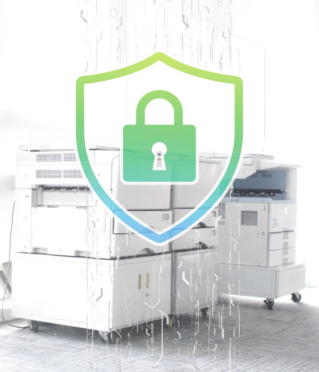Your managed print services strategy shouldn’t just be about keeping the toner flowing. You must also secure your print infrastructure.

The intelligence of today’s multi-function devices not only enhance employee productivity and collaboration. They also make them doorways for hackers who are threats to your endpoint security. A study released at the beginning of the year by Quocirca Global Print Security found that 11 per cent of security incidents reported by organizations over the previous 12 months were print-security related. Meanwhile, 59 percent of organizations reported an incident of print-related data loss during the same period.
If you don’t want to be one of those companies that reports a print-related security incident, you need to secure your data as it travels from each workstation to each printer, and you should start with your infrastructure.
One endpoint can be an unlocked door
Most organizations give a lot of thought to securing desktop computers and even have a strategy for Bring-Your-Own Device laptops and smartphones, but today’s modern multi-function devices can still get overlooked. More than half of all organizations don’t even include printers in their security strategy. Today’s multi-function printer is an intelligent, networked endpoint that’s become a favorite for threat actors looking for a doorway into your organization.
Your printers are just as likely to store sensitive information as your workstations and servers. Customer information protected under privacy legislation, your intellectual property and other confidential business documents are stored in printer caches and are low hanging fruit for hackers looking to leverage stole information for financial gain.
These threat actors won’t stop at a printer, either. Once they’ve gained access to one endpoint, that unsecured printer becomes a doorway to your entire network and any connected device in your organization. A compromised printer is the perfect platform for throttling your network with fake print jobs or as platform for launching a DDoS attack.
But the threats aren’t just electronic or external, either. Any unsecured, printed document can easily be stolen if abandoned on a printer tray for too long—even if it’s moved to the recycling bin by someone because the real owner never claimed it.
Endpoint security means thinking about more than just devices
It’s important to understand, however, that your print infrastructure isn’t just the devices that scan, copy and print. You need to consider the security of your print server too—the computer set aside to centralize printing and make all the print resources available to end users. When securing your print infrastructure, you must think about every aspect of the printing process from the moment a user presses “print” to when the paper goes through the roller and lands in the tray.
Ultimately, securing your print infrastructure means being able to answer the following questions:
- Do you know who’s printing what?
- Are your printers, scanners and copiers properly configured with security in mind? What about your print server?
- Is the physical location of each device secure?
- Are the network connections linking workstations and print devices properly safeguarded?
Nowadays, the ability to print from any device to a nearby printer is taken for granted, but securing your print infrastructure is something you can never become complacent about. Printers are vulnerable security endpoints that put your business at risk. A managed print services provider can help you evaluate your environment and get you started securing your print infrastructure.
RJ Sahi is practice manager for PrinterLogix. Download our printer security primer today to see how you can get started securing your print infrastructure today and improve endpoint security.
